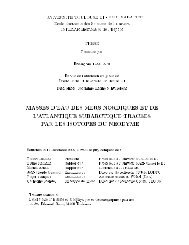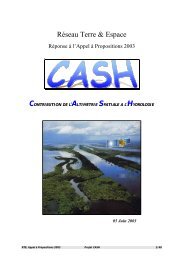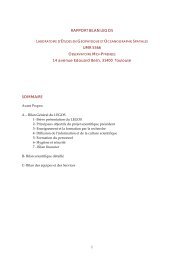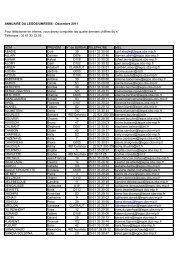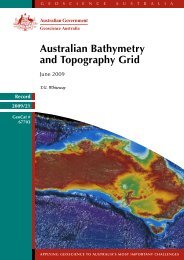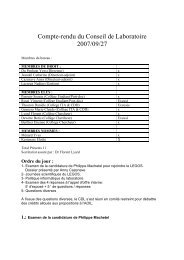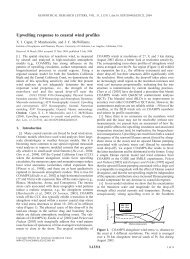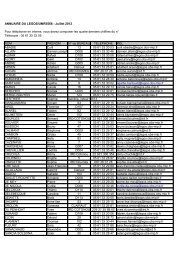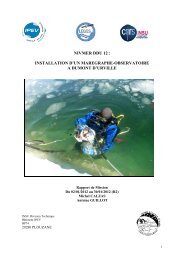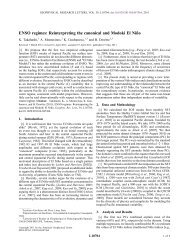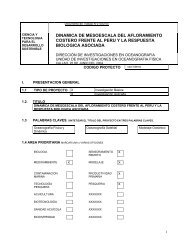Chaigneau and Pizarro - LEGOS
Chaigneau and Pizarro - LEGOS
Chaigneau and Pizarro - LEGOS
You also want an ePaper? Increase the reach of your titles
YUMPU automatically turns print PDFs into web optimized ePapers that Google loves.
C05014 CHAIGNEAU AND PIZARRO: CIRCULATION OF THE EASTERN SOUTH PACIFIC<br />
spatial decorrelation scales, <strong>and</strong> diffusivity, along with error<br />
estimates. We also determine the respective contributions of<br />
horizontal advection <strong>and</strong> turbulent diffusion on passive<br />
tracer fluxes. Mean advective <strong>and</strong> eddy diffusive temperature<br />
<strong>and</strong> salinity fluxes are thus estimated in the mixed layer<br />
of the whole study region. The ensemble of the results<br />
provides a useful tool for a comparison with the previous<br />
studies but also for the validation of both regional <strong>and</strong><br />
global models in the eastern South Pacific.<br />
[4] This work is organized as follows: section 2 describes<br />
the data sets <strong>and</strong> processing methods used; section 3 deals<br />
with the surface circulation <strong>and</strong> eddy kinetic energy; <strong>and</strong><br />
section 4 analyses Lagrangian scales of variability <strong>and</strong> eddy<br />
diffusivity. In section 5, we estimate the respective role of<br />
the large-scale advection <strong>and</strong> turbulent diffusive flow on the<br />
mixed layer temperature <strong>and</strong> salinity fluxes. Finally, section<br />
6 summarizes the study results.<br />
2. Data Set<br />
[5] The major data sets used in this study are surface<br />
satellite-tracked drifters <strong>and</strong> Topex-Poseidon/ERS1-2 altimeters<br />
measurements. Additionally, the World Ocean Atlas<br />
2001 (WOA) climatology <strong>and</strong> satellite ERS winds are also<br />
used. The study region extends from 10°S to34°S<strong>and</strong> from<br />
70°W to 100°W (Figure 1b).<br />
[6] The surface satellite-tracked drifters data set spans<br />
1979–2003 <strong>and</strong> is part of the Global Drifter Program/<br />
Surface Velocity Program. The drifters were equipped with<br />
a holey sock drogue centered at 15m depth in order to reduce<br />
surface drag induced by both wind <strong>and</strong> waves. The expected<br />
drogue slip relative to the water is less than 2 cm s 1 for<br />
winds up to 20 m s 1 [Niiler <strong>and</strong> Paduan, 1995; Niiler et al.,<br />
1995]. The Atlantic Oceanographic <strong>and</strong> Meteorological<br />
Laboratory (AOML, Miami) received the drifter positions<br />
from Doppler measurements from Service ARGOS. These<br />
positions, irregularly distributed in time, were therefore<br />
quality controlled <strong>and</strong> interpolated to uniform 6 hour intervals<br />
using an optimum interpolation procedure [Hansen <strong>and</strong><br />
Poulain, 1996]. Velocity components were calculated by a<br />
centered difference scheme at each 6 hour interval. In our<br />
study area, a total of 476 different drifters, able to exit <strong>and</strong><br />
return to the area, were followed. To remove high-frequency<br />
tidal <strong>and</strong> inertial wave energy <strong>and</strong> to avoid aliasing the<br />
energy into the low-frequency motions, the four daily drifter<br />
data were averaged over 24 hour intervals [Swenson <strong>and</strong><br />
Niiler, 1996; Martins et al., 2002]. A total of 72,244 daily<br />
buoy position <strong>and</strong> velocity data were thus obtained from<br />
1979 to 2003. Figure 1a shows the yearly distribution of the<br />
number of daily observations. In the study region for all the<br />
years between 1979 <strong>and</strong> 2003, the maximum amount of data<br />
were observed during the 1990s, corresponding to the World<br />
Ocean Circulation Experiment period, with a maximum of<br />
9948 observations in 1993 <strong>and</strong> none in 1980 <strong>and</strong> 1984. The<br />
results did not differ significantly when considering data<br />
from the last decade (1991–2003) or the entire study period,<br />
although the number of degrees of freedom was decreased.<br />
In order to reduce the errors, we thus prefer use the whole<br />
drifter data set. All seasons of the year were equally sampled<br />
(not shown), with a minimum of around 15,000 observations<br />
in austral summer (January to March) <strong>and</strong> a maximum of<br />
20,000 in austral spring (October to December). The results<br />
2of17<br />
obtained hereafter are thus representative of an annual mean<br />
state. Figure 1b shows the spatial coverage of the daily<br />
data (shading) in the study region, <strong>and</strong> the number of<br />
degrees of freedom or independent observations (see section<br />
3.1 for calculation explanation). The bins have a minimum<br />
size of 2° 2° latitude-longitude <strong>and</strong> are adjusted, especially<br />
along the Chilean coast, to contain more than 6 independent<br />
observations. Only 33 of the 152 cells contained less than 20<br />
independent data. The southwestern part of the region was<br />
extensively sampled, with more than 70 independent observations<br />
in each bin south of 24°S <strong>and</strong> west of 84°W. In<br />
contrast, along the continental coast, the grid cells contain<br />
only between 6 <strong>and</strong> 35 degrees of freedom. For practical<br />
reasons, we have chosen 50 daily data or 6 independent<br />
observations as a lower limit, to make a compromise<br />
between reasonable grid cell dimensions <strong>and</strong> robustness of<br />
the results.<br />
[7] The satellite altimetry data set used in this study is the<br />
gridded product of Topex/Poseidon, ERS-1/2, <strong>and</strong> Jason-1<br />
sea level anomalies (SLA) provided by Archiving Validation<br />
<strong>and</strong> Interpretation of Satellite Data in Oceanography<br />
(AVISO). This data set spans 1993–2003, with weekly SLA<br />
distributed on a 1/3° Mercator Grid. The methods used to<br />
process the data <strong>and</strong> reduce the errors are described by Le<br />
Traon et al. [1995] <strong>and</strong> Le Traon <strong>and</strong> Ogor [1998] <strong>and</strong> by<br />
Ducet et al. [2000]. Zonal <strong>and</strong> meridional components of<br />
the residual sea surface velocity components were calculated<br />
from the SLA, using the geostrophic relationship<br />
V 0 g<br />
U 0 g<br />
¼ g<br />
f<br />
¼ g<br />
f<br />
@ ðSLAÞ @y<br />
@ ðSLAÞ ;<br />
@x<br />
where g is the acceleration due to gravity, f is the Coriolis<br />
parameter, <strong>and</strong> @x <strong>and</strong> @y are the eastward <strong>and</strong> northward<br />
distances.<br />
[8] Time mean eddy kinetic energy (per unit of mass),<br />
EKE, is calculated using<br />
EKE ¼ 1<br />
2<br />
U 0 2<br />
g þ V 0 2<br />
g<br />
where the overbar denotes time average.<br />
[9] Monthly temperature <strong>and</strong> salinity climatologies on a<br />
1/4° latitude 1/4° longitude grid from the World Ocean<br />
Atlas were used to estimate surface geostrophic velocities<br />
relative to 1750 m depth. Generally, the common reference<br />
level is chosen at around 3500 m in the study region<br />
[Shaffer et al., 2004; Leth et al., 2004], but as this area<br />
is one of the least-sampled of the world oceans, the use of<br />
a climatology down to 3500 m may introduce important<br />
errors rather than improve our results. Furthermore, based<br />
on three hydrographic sections, Leth et al. [2004] show<br />
that the maximum horizontal velocity between 1750 m <strong>and</strong><br />
3500 m depth is less than 0.02 cm s 1 in the study area.<br />
Therefore we suppose that the 1750 m reference level does not<br />
introduce a significant error in the surface velocity calculation.<br />
In contrast to geostrophic velocities estimated from<br />
;<br />
C05014





